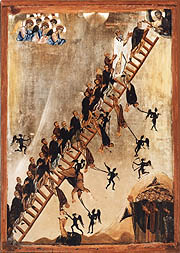Ladder of Divine Ascent icon

The Icon of the Ladder of Divine Ascent is connected with the well-known spiritual classic book entitled The Ladder of Divine Ascent by Saint John Climacus, of the seventh century. His memory is celebrated on March 30 and on the Fourth Sunday of the Great Lent, and the icon is usually venerated in churches on the same days.
Contents
[hide]Design
In the icon, a ladder stands on the earth and reaches to Heaven. Monks are seen trying to climb the ladder, and winged demons are seen pulling them off. Over the top of the ladder is Christ, emerging from Heaven.
At the right side of the scene is shown a monastery building. Standing outside its door is St. John Climacus. His right hand points at the ladder and watching monks stand behind him. In his left hand he holds a scroll on which is written: "Ascend, ascend, Brethren."
In the top left corner, opposite the monastery, are angels shown clothed in light-colored garments and having large, strong wings.
Theology
St. John describes thirty stages of spiritual development in his book. He likens the stages to thirty steps upward on a ladder. The steps lead to theosis, the ultimate goal of the spiritual striver. The icon was inspired by this book.
Just as St. John's book, the icon stands as a witness to the violent effort needed for entrance into God's Kingdom. The spiritual struggle of Christian life is a real one, "not against flesh and blood, but against the rulers of the present darkness the hosts of wickedness in heavenly places" (Ephesians 6:12).
Ladder
The Ladder of St. John Climacus was inspired by the Ladder which the righteous Jacob saw in a dream. Jacob saw a ladder which rose from earth to Heaven, on which some angels were ascending and others were descending. His vision is described in the book of Genesis: "Jacob dreamed, and behold a ladder set up on the earth, and the top of it reached to Heaven, and the Angels of God were ascending and descending on it. And the Lord leaned upon it and said: I am the God of Abraham your father, and the God of Isaac; be not afraid.... And behold, I am with you, and will keep thee in all places wither thou goes" (Genesis 28:12-13, 15).
The ladder in this icon is sometimes depicted in such a way to express the idea that more effort is required for rising to the highest levels of spiritual development.
Christ from Heaven
With His right hand Christ blesses the monk who has climbed to the top of the ladder. The scroll in His left hand is symbolic of His Gospel.
Reaching this heaven is a heaven of the mind within the heart. Its effect is to sanctify the mind and to detach it from material things, and it does so in such a way, that after entering this heavenly harbor, a man, for most of his earthly life, is enraptured, like someone already in heaven, and he is lifted up to the contemplation of God.
Climbing monks
Below the victorious monk, there are other monks at various stages of ascent. Some stand on the ladder firmly, and are about to rise to the next rung. Others, however, are barely retaining their hold, as they are drawn by demons.
One of the monks has fallen off the ladder and is being swallowed by a dragon with wide open jaws.
Demons
The demons are flying at the ladder. The demons are depicted in order to remind the observer that they exist. Such evil spiritual beings, act upon us through mental suggestion and assaults. Their tails symbolize their fallen state, their animalistic state.
The demons also symbolize various sins. Saint John's book minutely analyzes the nature of the passions of pride, gluttony, lust, anger, despondency, malice, and so on.
Dragon
The dragon is used as a symbol of Hell.
Angels
Angels are viewed as real beings.
The angels also symbolize positive qualities, virtues, the opposites of the "passions," humility, temperance, chastity, gentleness, hope, love, etc.
External links
- The Ladder of Divine Ascent from Orthodox Tradition, Vol. XII, No. 4, pp. 60-63.
- The Fourth Sunday of Lent: Feast of our Righteous Father John (Climacus) of Sinai, Author of The Ladder of Divine Ascent (GOARCH)
